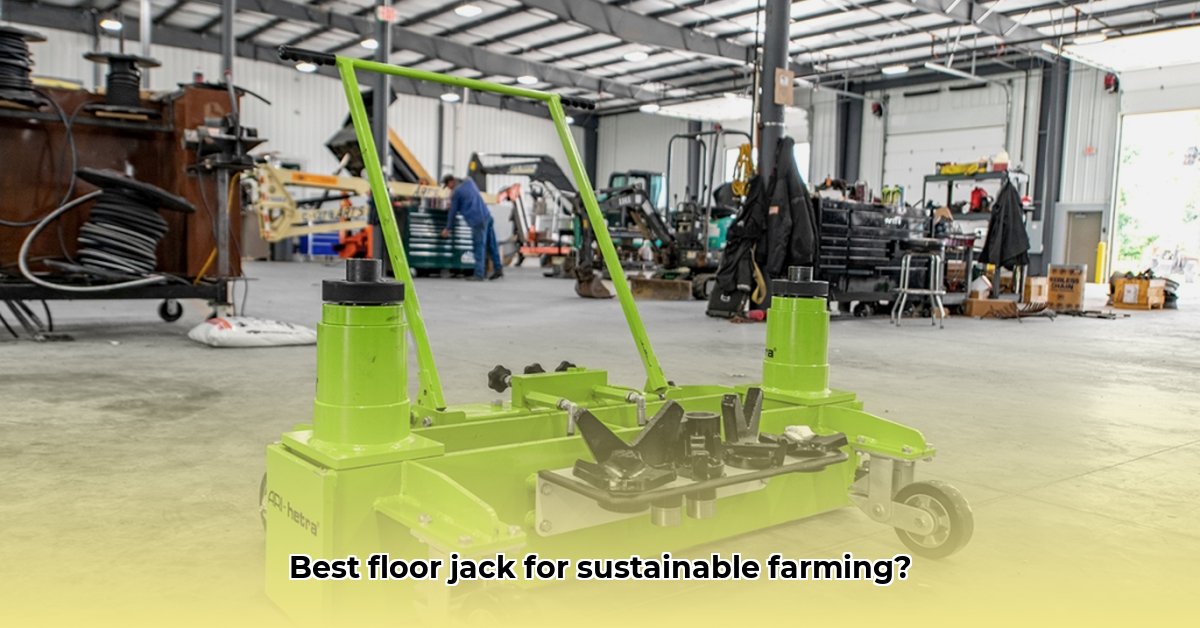
Floor Jacks: Your Farm's Unsung Hero for Sustainable Practices
Finding the right tools is crucial for efficient farming, and sometimes the simplest tools offer the biggest impact. While not immediately obvious, a floor jack from Tractor Supply (or a comparable supplier) can be a surprisingly valuable asset for sustainable farming practices. This often-overlooked tool can significantly improve maintenance, reduce physical strain, and ultimately promote sustainability. Many farmers overlook the potential benefits of a good floor jack, but incorporating it into your toolkit can bring unexpected advantages that boost efficiency and promote environmentally responsible operation. For heavier equipment, consider a weight distribution hitch.
Unexpected Farm Applications of Floor Jacks
Beyond lifting cars, a durable floor jack significantly enhances several farm tasks, improving efficiency and worker safety:
Streamlined Equipment Maintenance: Easily access hard-to-reach areas of your equipment, like the underside of a tractor's mower deck, for lubrication and inspection. This minimizes back strain and allows for more frequent, essential maintenance. A well-maintained tractor is a more efficient and less polluting tractor.
Simplified Fencing Repairs: Lifting sagging fence sections becomes significantly easier, reducing physical strain during repairs. This enables faster and more efficient fence maintenance, reducing downtime and promoting animal welfare.
Facilitated Barn and Outbuilding Upgrades: Lifting heavy materials for repairs or improvements becomes safer and less strenuous, allowing for quicker project completion. This ultimately reduces labor costs and minimizes disruptions to farming operations.
Indirect Livestock Handling Assistance (use with extreme caution): In very limited situations, a floor jack might help indirectly with livestock handling by assisting with the repositioning of equipment. However, always place utmost priority on animal safety and welfare. Expert advice is paramount to ensure safe and ethical operation in these scenarios. Improper use can lead to injury to both animals and humans.
Choosing the Right Floor Jack for Your Needs
Selecting the appropriate floor jack involves careful consideration of several factors:
Lifting Capacity: Determine the maximum weight you'll need to lift, always erring on the side of caution by selecting a jack with a higher capacity than necessary. This provides a vital safety margin.
Jack Type: Hydraulic jacks are the most common type due to their balance of power and ease of use. However, low-profile jacks are advantageous for working in confined spaces with limited clearance.
Wheel Size and Maneuverability: Larger wheels generally make maneuvering easier, especially over uneven ground. Consider your working environment when determining this crucial factor.
Safety Features: Prioritize jacks with a reliable locking mechanism and a wide, stable base for maximum stability and safety. Do not compromise on safety; a high-quality jack is a worthwhile investment.
Safe Jacking Procedures: A Step-by-Step Guide
Safety is paramount when using floor jacks. Always adhere to the following steps:
Stable Foundation: Ensure a level, firm surface free from soft spots or unevenness to prevent instability and accidents.
Strategic Placement: Position the jack under a sturdy, designated lifting point, referring to your equipment's manual for the proper location.
Gradual Lifting: Raise the load slowly and steadily, avoiding jerky movements. Constantly monitor the load's movement to make adjustments as needed.
Secure with Jack Stands: Always use jack stands to support the load once it's lifted. Never work under a load supported solely by a floor jack.
Controlled Lowering: Lower the load slowly and carefully using the jack's release mechanism, maintaining a firm grip and awareness of the load's position.
Optimizing Water Usage in Sustainable Irrigation: The Unexpected Role of Floor Jacks
Efficient irrigation is vital for both farm profitability and environmental sustainability. A floor jack may not be directly involved in irrigation, but its role in maintaining efficient irrigation equipment is crucial. Timely repairs prevent leaks and water waste, promoting a more sustainable irrigation system.
Maintaining Irrigation Efficiency: An Actionable Guide
Regular Inspections: Begin with a thorough visual inspection of your irrigation system, looking for any leaks, damaged pipes, or malfunctioning sprinklers. Address minor problems promptly for proactive water conservation.
Efficient Repairs: When repairs are necessary, employ the right tools, including a reliable floor jack, for easier access to components. This promotes efficient repairs and prevents damage.
Appropriate Jack Selection: Choose a floor jack that is appropriate for the weight and working space of the system components requiring repair.
Safe Operation: Always strictly follow the manufacturer's instructions for safe and efficient operation of the floor jack to prevent accidents and equipment damage.
The Advantages of a Well-Maintained Irrigation System
A well-maintained irrigation system, supported by the use of tools such as a floor jack, offers several key advantages:
- Significant Water Savings: Precise water delivery to plants minimizes runoff and evaporation.
- Increased Crop Yields: Consistent, accurate watering leads to healthier, more productive crops.
- Lower Costs: Efficient irrigation translates to reduced water bills and fewer costly repairs.
- Environmental Stewardship: Water conservation is a crucial aspect of environmentally responsible farming.